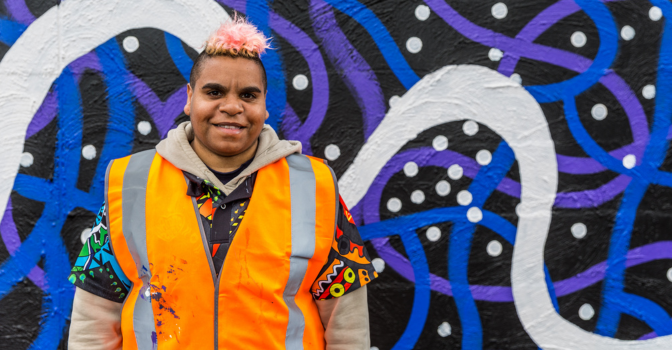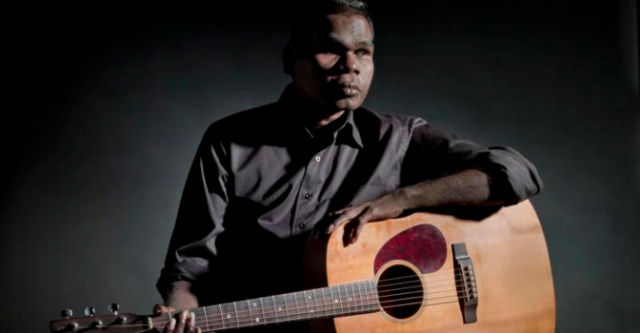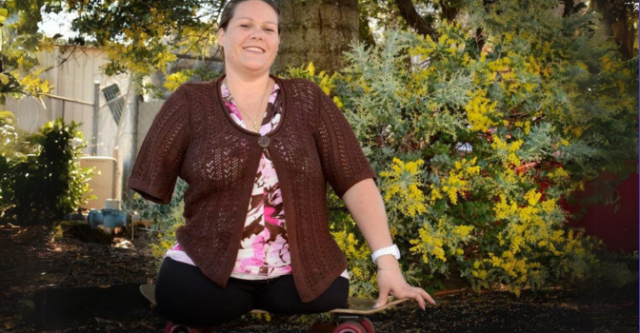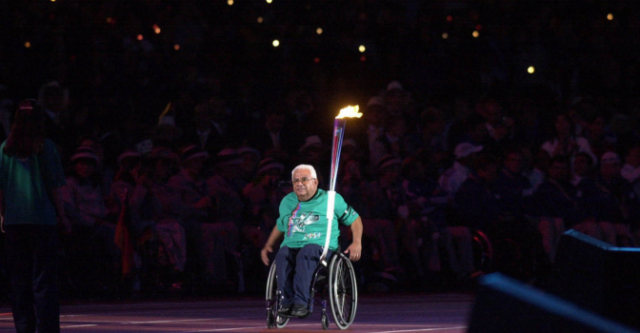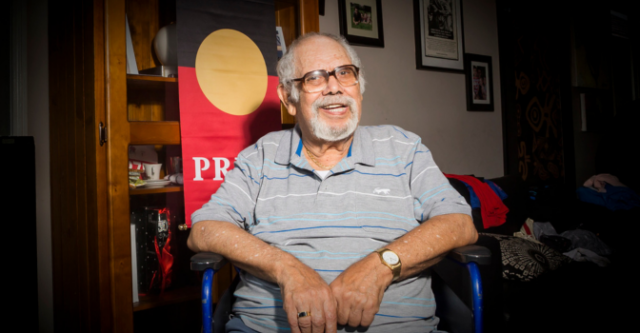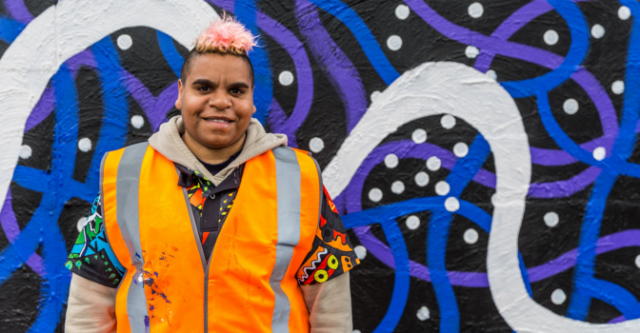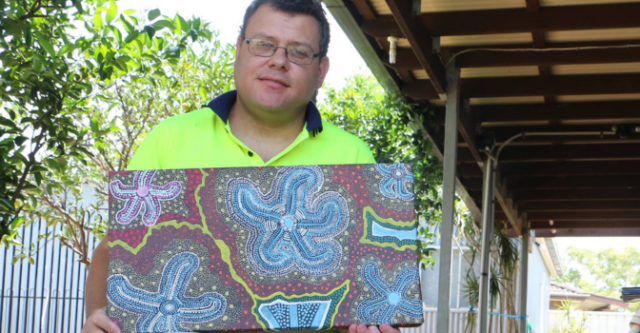Aboriginal and Torres Strait Islander peoples should be aware that this story contains images or names of people who have passed away.
This week is National Reconciliation Week! It is an important event that encourages Australians to explore and celebrate the shared histories, cultures and rich diversity that characterises our nation.
To mark the occasion the Leap in! Crew has put together a collection of profiles that shine a light on six remarkable First Nations Australians with disability. These individuals have made significant contributions to music, sports, art and advocacy.
Geoffrey Gurrumul Yunupingu.
Known simply as Gurrumul, Geoffrey Gurrumul Yunupingu was a Yolŋu Aboriginal Australian musician whose voice touched the hearts of many. Despite being born blind, Gurrumul’s extraordinary talent as a multi-instrumentalist and singer propelled him to international fame.
He is best known for his album “Djarimirri (Child of the Rainbow)” which made history as the first album performed in an Australian Indigenous language to top the charts.
Before breaking out as a solo artist, Gurrumul played with Yothu Yindi and Saltwater Band.
He was skilled on drums, keyboards and didgeridoo, and even played a right-hand-strung guitar with his left. He sang in several different Yolŋu languages and English, blending culture through his music.
Gurrumul’s ability to blend traditional Yolŋu music with contemporary sounds made him a pivotal figure in the music world.
Tracy Barrell, OAM.
Tracy Barrell is a proud Bundarra woman and a triple congenital amputee Paralympic swimmer.
In addition to winning two gold medals at the 1992 Barcelona Paralympics, Tracy was awarded a Medal of the Order of Australia (OAM) for her services to sport. You might remember her as a person who chose to use a skateboard rather than a wheelchair or prosthetic legs to get around.
The strength and tenacity that helped Tracy succeed in sport has also made her an excellent advocate for people with disabilities. Tracy’s grit and sense of humour continue to inspire others to see beyond limitations and focus on abilities.
“I was born without legs or an arm, I live a very fulfilled life. I see myself as a person living with a difference, it’s people’s perceptions or facilities that put the Dis in My Abilities. I’m a dual Gold medallist, Order of Australia Medal holder and a mother of two wonderful boys!” – Tracy Barrell.
Kevin Coombs, OAM PLY.
Originally from Swan Hill, Victoria, Kevin Coombs was a cherished Wotjobaluk Elder. He was the first Aboriginal Paralympic competitor for Australia and a vital member of Australia’s wheelchair basketball teams for decades.
In total, Kevin competed with the Australian men’s wheelchair basketball team at five Paralympic Games, twice as the team captain. Kevin and his teams found success in several international competitions including a silver medal at the 1974 Commonwealth Paraplegic Games and gold medals at the 1977 and 1982 FESPIC Games.
He was more than just a trailblazing athlete with disability; he was a powerful advocate for Indigenous health. In 1983 Coombs received a Medal of the Order of Australia “in recognition of service to sport for the disabled and to Aboriginal welfare”.
His induction into the Australian Paralympic Hall of Fame and the creation of The Uncle Kevin Coombs Medal for the Spirit of the Games further underscore his impact.
Lester Bostock.
Known affectionately as Uncle Lester, Bostock was a pioneer in Aboriginal disability rights and a trailblazer in the media industry.
As an amputee and proud Bundjalung man, he broke barriers in the film and television industry, paving the way for Indigenous filmmakers and journalists. He founded several organisations including:
- Black Theatre: an Aboriginal-run theatre company
- Metro Screen: a not-for-profit film, television and digital media training organisation
- Radio Redfern: a radio program dedicated to the Aboriginal community, which still exists as Koori Radio.
Uncle Lester was an advocate for Indigenous representation in media and was responsible for establishing policies on filming in Aboriginal communities and for creating Indigenous Employment at the SBS. He was also the first First Nations person who was heard on SBS radio.
“That was what [my life] was all about: helping other people and creating change.” – Lester Bostock.
Jackie Saunders
Jackie Saunders is a proud Ngarrindjeri and Wirangu woman who lives with Foetal Alcohol Spectrum Disorder (FASD), which impacts various aspects of her daily life. She is an award winning artist with talents in singing and visual arts.
Jackie has had several major roles in productions from Tutti Arts, a South Australia based art centre. Her performance in Northern Lights Southern Cross brought her all the way to Minneapolis, USA in 2009.
Between 2012 and 2019 Jackie was a member of the all-female pop group The Sisters of Invention. The five young women, all with disability, met through Tutti Arts.
In 2020 Jackie decided to pick up a paintbrush and shift her focus to the canvas. Her talent was quickly recognised and Jackie was invited to be part of ACE’s exhibition If the Future is to be Worth Anything: 2020 South Australian Artist Survey.
She won the 2020 Dawn Slade-Faull Award which enabled her to present her first solo exhibition, Salt & Sand at Dentons Fisher Jeffries.
Jackie is still a passionate artist and an active member of Tutti Arts and the wider artistic community in South Australia. She hopes her work will inspire young Indigenous people to pursue their dreams.
“I’m a role model to young Indigenous people and I want to keep that going to show them if you put your mind to it, you can achieve your dreams.” – Jackie Saunders.
Joseph Formosa
Joseph Formosa is a blind and deaf artist who takes inspiration from the natural world to create designs that tell stories of resilience and solitude. Due to Usher Syndrome, Joseph has very limited hearing and only 3 per cent vision but he has adapted his creative process to suit his needs.
His artwork starts with a digital camera that he uses to capture images of sea creatures. At home he enlarges the images on a computer screen and sketches the details onto paper or canvas. He then adds colour with dot painting and Aboriginal motifs.
Joseph has been able to learn more about his Indigenous heritage through art and better understand the connection that he has with nature and especially the ocean.
His mother is part of the Yuin nation on the New South Wales south coast. He also has connections at the Raymond Terrace Indigenous Men’s Shed.
In 2020 Joseph’s art was featured in NAIDOC Exhibition 2020 in Newcastle. His paintings tell stories of resilience and adaptation. Through his art, Joseph finds connection and meaning, proving that creativity knows no bounds.
“Each painting I do I try to tell the story about how solo or groups of sea creatures can cope while alone and away from the world. This is similar to the way I face the world every day with my limited sight and total deafness.” – Joseph Formosa.
Now more than ever.
These stories remind us of the strength, resilience, and talent that flourishes within Indigenous communities, including people with disability.
Each of us has a part to play in creating a more inclusive and equitable society for all Australians so as we celebrate National Reconciliation Week, let’s honour the remarkable contributions of Aboriginal and Torres Strait Islander people with disability.

